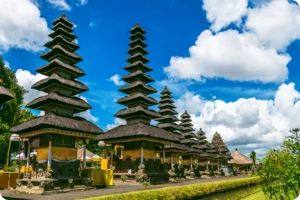When people think of Bali, their minds usually drift to turquoise beaches, serene rice terraces, and luxurious resorts. But there’s a whole other side to the Island of the Gods that travelers often overlook—the thriving art and museum scene, especially in Ubud, Bali’s cultural capital.
Whether you’re an art enthusiast, history buff, or simply looking for something more enriching than another day at the beach, Bali’s museums and galleries offer a fascinating dive into its soul. In this guide, we’ll walk you through eight must-visit art galleries and museums in Bali, along with helpful information to plan your trip wisely.
Bali’s Thriving Art Scene: What to Expect
Bali has long been a magnet for artists and creatives from all over the world. It is a sanctuary for artists and a living showcase of Indonesian creativity. Over the years, its deeply spiritual atmosphere, strong community ties, and aesthetic traditions have fostered a thriving ecosystem for both classical and contemporary art. The result? A diverse museum landscape that speaks to every kind of traveler—from history buffs to casual tourists, families, and art collectors.
Own your COCO property in paradise with benefits for life
- +200 properties in construction
- +250 properties in full operation
- Pay 20% of your property straight from rental profit
Art Galleries and Museums
Art museums and galleries in Bali capture the island’s artistic evolution—from sacred, traditional works rooted in mythology and ritual to thought-provoking contemporary pieces that explore modern identity, culture, and global issues. These institutions often feature both permanent and rotating exhibitions, showcasing a wide spectrum of styles such as classical Balinese painting (like Kamasan and Batuan), abstract compositions, mixed media, and avant-garde installations.
Many of these galleries serve not just as exhibition spaces but also as hubs for artistic engagement. Visitors can purchase original artworks, prints, and sculptures, or take part in artist-led workshops, live demonstrations, and curated talks. These venues go beyond visual appreciation; they invite guests to explore the deeper cultural, spiritual, and symbolic meanings behind the art, helping to deepen appreciation for the rich visual language of the island.
History and Culture Museums
If you’re looking to understand what makes Bali unique, cultural and historical museums are essential stops. These spaces go beyond the visual—they’re repositories of memory and tradition, capturing the island’s transition from ancient kingdoms to its present-day cultural hybridism.
These museums often house collections of ceremonial objects, religious icons, royal heirlooms, weaponry, textiles, historical documents, and architectural models, all enriched with context about Balinese customs, caste systems, spiritual practices, and daily rituals. Many of these museums enhance the experience through multimedia displays, dioramas, and guided storytelling to immerse visitors in the island’s living traditions.
Nature and Science Museums
Nature and science museums in Bali may be fewer in number, but they offer a compelling alternative for travelers interested in the island’s natural world. These museums typically focus on Bali’s biodiversity, ecology, and environmental heritage.
Expect exhibits that explore everything from tropical flora and fauna to marine ecosystems and geological formations. While some museums may center on specific species—such as butterflies or marine life—others broaden the scope to include the island’s geological history, native habitats, and conservation efforts. Some of these museums also serve educational purposes, especially for school-age children and students, blending entertainment with scientific learning.
Their value lies in connecting visitors to Bali’s environment beyond its touristic charm. These museums often highlight the delicate balance between human activity and natural preservation, underscoring the importance of protecting Bali’s unique ecosystems amid rapid development and tourism.
Interactive Museums
Interactive museums are an increasingly popular format in Bali, appealing especially to families, digital natives, and travelers looking for immersive experiences. Unlike traditional museums, these are designed for participation rather than observation. Therefore, visitors are encouraged to touch, pose, play, and even become part of the art.
The focus is often an illusion, perspective, and sensory interaction. Many of these museums incorporate 3D wall art, mirror tricks, optical illusions, augmented reality, or thematic sets. The experience is fun, hands-on, and highly visual, perfect for social media sharing but also surprisingly educational.
These spaces are excellent for introducing children and museum-averse travelers to the world of visual art in a relaxed, entertaining format. They challenge conventional ideas of what a museum can be and reflect how Balinese creativity adapts to modern audiences without losing its inherent charm.
Transform Your Life With a Lifestyle Investment
Take control of your future by owning property in Bali. It’s not just an investment; it’s a lifestyle upgrade that balances work, leisure, and global living.
Popular Art Galleries, Museums, and Cultural Attractions in Bali You Must Visit
Now that you’re made aware of Bali’s dynamic museum and gallery scene, let’s dive into the standout venues you shouldn’t miss. Whether it’s a quiet cultural stop in Ubud or a photo-worthy museum in Nusa Dua, this list covers the spectrum.
A. Art Museums
1. Agung Rai Museum of Art (ARMA) – Ubud

The Agung Rai Museum of Art, commonly known as ARMA, stands out not just as a museum but as a vibrant cultural hub in Ubud. Founded by Balinese art patron Agung Rai, ARMA offers an extensive collection that spans classical Kamasan paintings on tree bark, detailed works from the Batuan school of the 1930s, and pieces by notable foreign artists like Walter Spies and Raden Saleh, who drew inspiration from Bali’s mystique.
Unlike more static museum experiences, ARMA is designed to be immersive. Visitors are encouraged to explore not only the art galleries, but also the museum’s beautifully landscaped grounds, where traditional dance performances, shadow puppet shows, and gamelan music sessions regularly take place. The center also hosts workshops and classes in Balinese painting, dance, and other traditional crafts—making it ideal for travelers who want to do more than observe and truly engage with the island’s cultural heritage.
- Location: Jl. Raya Pengosekan Ubud, Ubud, Kecamatan Ubud, Kabupaten Gianyar, Bali 80571
- Entrance fee: IDR 150,000 (or about $9.25)
- Opening hours: 9:00 AM – 6:00 PM
- Amenities: Cultural workshops, café, gift shop, performances, hotel
- Must-See: Works by Raden Saleh, Walter Spies, and Lempad
2. Neka Art Museum – Ubud

If you’re seeking a quiet yet enriching escape into Bali’s artistic soul, the Neka Art Museum in Ubud offers a compelling stop.
Founded in 1976 by Balinese art teacher and collector Suteja Neka, the museum was inspired by a desire to preserve and celebrate Balinese visual culture. Today, it stands as one of the most respected art institutions on the island, offering an immersive journey through the evolution of Balinese, Indonesian, and cross-cultural artistic expression.
Spread across several thoughtfully curated pavilions, the museum presents an extensive collection that spans classical, traditional, and contemporary styles. Highlights include intricate wayang-style paintings, Batuan-style works, and modern pieces from the Ubud, Young Artist, and Lempad schools. The museum also features notable works by Indonesian greats like Affandi, Raden Saleh, and Hendra Gunawan, as well as internationally recognized artists such as Rudolf Bonnet, Arie Smit, Willem Gerard Hofker, and Antonio Blanco—all of whom found lasting inspiration in Bali’s cultural richness.
Specialized pavilions enrich the experience:
- Lempad Pavilion honors the traditional genius of I Gusti Nyoman Lempad.
- Affandi Pavilion showcases the powerful expressionism of one of Indonesia’s most celebrated painters.
- Arie Smit Pavilion traces the development of the Young Artist style he helped pioneer.
- East-West Art Annex presents a dynamic fusion of Indonesian and foreign perspectives.
- Keris Pavilion exhibits ceremonial daggers, rich with symbolic and spiritual significance.
- A Photography Pavilion displays rare black-and-white images from the 1930s–1940s, offering glimpses into pre-tourism Bali.
Following extensive renovations by the next generation of Neka’s family, the museum now includes modernized layouts, building upgrades, and interactive digital labels for many artworks—enhancing engagement without disrupting the peaceful, meditative setting.
- Location: G753+2F7, Jl. Raya Sanggingan Jl. Raya Campuhan, Campuhan, Kedewatan, Kecamatan Ubud, Kabupaten Gianyar, Bali 80571
- Entrance fee: IDR 150,000 for adults (or about $9.25); IDR 75,000 ($4.55) for students and children
- Opening hours: 9:00 AM – 5:00 PM
- Amenities: Garden walkways, bookstore, café
why investors choose
coco development group?

Passive income on full auto pilot
Profit Maximization
We do not just put your property on Airbnb hoping for a guest to book it. More than 40% of our bookings comes today through our own medias, a strong community and a digital and data driven management approach.
A Convenient and fast payment system
The investors receive net profits currency that is convenient for them. we transfer the money once every three months
No need to handle taxes
High Liquidity
Fast Payback
Oceanside villas in Bali are in High demand for daily rentals. You will earn about 5000 USD per month
3. The Blanco Renaissance Museum – Ubud

If you’re drawn to bold creativity and dreamlike artistry, a visit to the Blanco Renaissance Museum in Ubud promises an unforgettable dive into one of Bali’s most eccentric and iconic art spaces.
Perched on a hilltop overlooking the Campuhan River, the Blanco Renaissance Museum is a haven for art enthusiasts seeking a glimpse into the whimsical and provocative works of Spanish artist Antonio Blanco. Known for its vivid depictions of Bali’s beauty and culture, especially its women, the museum houses over 300 captivating paintings in various mediums.
Honoring the painter’s fascination with Balinese women, you will see female staff dressed in traditional Balinese clothes all throughout the museum and oftentimes, women dressed the same preparing delicate flower and palm leaf offerings, adding an authentic cultural touch to your visit. Additionally, you may also check out the collection of Blanco lithographs and books, available for purchase as a unique memento of your experience.
The former home of flamboyant Spanish-American painter Antonio Blanco, this museum is part art gallery, part eccentric mansion. His artworks are expressive, sensual, and wildly imaginative. And even if his style isn’t your cup of tea, the location—perched above the Campuhan River—is worth the visit.
- Location: Jl. Raya Campuhan, Sayan, Kecamatan Ubud, Kabupaten Gianyar, Bali 80571
- Entrance fee: IDR 100,000 for adults ($6.00)
- Opening hours: 9:00 AM – 5:00 PM
- Amenities: Scenic views of the river, gardens, on-site art studio
4. Le Mayeur Museum – Sanur

If you like art with a touch of history and romance, then head over to the Le Mayeur Museum for a unique window into Bali’s cultural past told through the vivid, passionate works of a painter deeply enamored with the island and his muse.
Nestled in a charming beachfront home in Sanur, this museum was once the residence of Belgian artist Adrien-Jean Le Mayeur and his wife, Ni Pollok, a celebrated Legong dancer. His paintings—mostly impressionistic depictions of Balinese women, lush tropical landscapes, and daily island life—are now preserved here. After Le Mayeur’s passing in 1958, Ni Pollok transformed their home into a museum, allowing visitors to experience his life’s work and their shared love for Balinese art.
Today, around 80 of his paintings are on display, along with traditional Balinese masks, sculptures, and artifacts he collected over the years. The museum itself has retained its original charm, with intricately carved wooden doors, antique furniture, and an ambiance that transports you back to a time before Bali’s tourism boom.
But keep your expectations in check! This isn’t a modern, air-conditioned gallery—it’s a preserved piece of history, and the traditional setting means no air conditioning and a rustic, old-world feel. The entrance fee is IDR 50,000, which some may find a bit steep, but if you appreciate art and want to experience an authentic piece of Bali’s past, it’s definitely well worth it!
- Location: 87G7+2FV, Jl. Hang Tuah, Sanur Kaja, Denpasar Selatan, Kota Denpasar, Bali
- Entrance Fee: IDR 50,000 ($3.00) for adults and IDR 25,000 ($1.50) for kids
- Opening Hours: 8:00 AM – 2:00 PM
- Amenities: Beachfront location, preserved colonial-era home
B. History & Culture Museums
5. Bali Museum – Denpasar

If you’re curious about Bali’s rich history and culture, the Bali Museum in Denpasar is a great place to start. Located next to Denpasar’s main square and temple, this museum offers an in-depth look at the island’s cultural evolution from prehistoric times to the modern era.
The museum is organized into several pavilions, each dedicated to different aspects of Balinese life, including traditional architecture, rituals, weaponry, and daily tools. Exhibits include everything from ancient inscriptions and ceremonial artifacts to Bronze Age weapons, musical instruments, puppets, paintings, and household items.
Built in 1910 by Dutch officials who aimed to preserve Balinese heritage, the museum’s layout mirrors the design of a traditional royal temple, with areas representing the kahyangan (spiritual space), pura (temple), and merajan (family shrine). Today, the museum has expanded to include additional pavilions, a library, artifact restoration rooms, and even a small theater.
And while it’s not flashy, the Bali Museum offers an authentic and educational experience, especially for first-time visitors wanting a deeper understanding of the island’s roots.
- Location: Jl. Mayor Wisnu No.1, Dangin Puri, Kec. Denpasar Tim., Kota Denpasar, Bali 80232
- Entrance Fee: IDR 50,000 ($3.00) for adults and IDR 25,000 ($1.50) for kids
- Opening Hours: 8:00 AM – 4:00 PM
- Amenities: Guided tours available, central city access
Own Your Bali Paradise Home With Zero Hassle
From land acquisition to construction and property management, we handle every detail. You simply reap the rewards.
6. Setia Darma House of Mask and Puppets – Gianyar

If you’re drawn to global folklore and theatrical traditions, the Setia Darma House of Masks and Puppets near Ubud is a cultural treasure worth exploring. Set within traditional Javanese joglo houses and surrounded by rice fields and a quiet village setting, this unique museum offers a serene yet immersive journey through the world of performance art.
Founded in 2006, the museum was established to preserve, educate, and inspire appreciation for traditional masks and puppetry. It now houses an extensive collection of more than 1,300 masks and 5,700 puppets from across Indonesia and around the world.
Inside, as you move through the intricately designed exhibition spaces, you’ll encounter everything from Balinese barong and wayang puppets to African ceremonial masks and Japanese noh figures—each piece offering insight into the storytelling and spiritual traditions of its origin.
Beyond the exhibits, the 1-hectare property includes a theater, a Balinese house, a discussion room, and an open-air amphitheater that hosts cultural events and performances.
- Location: Jalan Tegal Bingin, Banjar Tengkulak Tengah, Kemenuh, Sukawati, Gianyar Regency, Bali 80582
- Entrance Fee: No official entrance fee; donation-based
- Opening Hours: 8:00 AM – 4:00 PM
- Amenities: Lush gardens, theater, discussion room, amphitheater
C. Nature & Science Museums
7. Bali Butterfly Park – Tabanan

If you’re not that into museums or cultural sites and prefer connecting with nature and living things instead, Bali Butterfly Park in Tabanan offers a refreshing change of pace. It’s a serene escape where you can walk among fluttering wings, explore the butterfly life cycle up close, and enjoy a peaceful moment surrounded by tropical greenery.
The park, set in over 3,000 square meters of tropical gardens, is home to hundreds of butterfly species, including rare ones like the vibrant Papilio peranthus and the striking Ornithoptera priamus. Here, you can walk freely among the fluttering butterflies, providing a tranquil and up-close wildlife experience.
Beyond just admiring their beauty, the park offers a fascinating educational experience. Visitors can explore nursery areas to observe the full butterfly life cycle—eggs, caterpillars, chrysalises, and emerging butterflies—while learning about their critical role in pollination and ecosystem health. Informational displays and knowledgeable staff further enhance the learning experience, providing engaging insights for both kids and adults.
In addition to butterflies, the park features a collection of preserved insects, including beetles and spiders, broadening the scope of your entomological adventure. Whether you’re a nature enthusiast, a parent, or simply in need of a peaceful escape from Bali’s bustling attractions, Bali Butterfly Park is a serene, enriching destination that beautifully blends nature, education, and conservation.
- Location: Jalan Tegal Bingin, Banjar Tengkulak Tengah, Kemenuh, Sukawati, Gianyar Regency, Bali 80582
- Entrance Fee: IDR 100,000 ($6.00) for adults and IDR 50,000 ($3.00) for children
- Opening Hours: 8:00 AM – 5:00 PM
- Amenities: Gardens, small insect exhibits, educational rooms for guides
8. Bali Shell Museum – Nusa Dua

If you’re a fan of marine life or simply intrigued by the wonders of the ocean, the Bali Shell Museum is a hidden gem worth exploring. This unique museum, located in Kuta on Sunset Boulevard, houses one of the largest collections of seashells in the region, some of which are over 500 million years old. It’s the only shell museum in Indonesia and offers an immersive experience across three well-organized floors.
Here, the first floor features an array of shell-based accessories, while the second floor showcases an impressive collection of shells in various sizes and ages. Among its standout displays is Crinions, the largest shell fossil in Asia. The third floor is dedicated to extraordinary marine life exhibits, including a massive whale spine and fish jaws, offering visitors an enriching look into marine biology.
Founded by a passionate collector who began amassing shells as a child, the museum also offers a chance to purchase shell-based souvenirs on the first floor. Beyond just a collection of beautiful specimens, the museum educates visitors on the ecological importance of shells and mollusks, making it an ideal stop for nature lovers, history buffs, and anyone interested in marine conservation.
- Location: Jl. Sunset Boulevard Kuta, Bali, Indonesia
- Entrance Fee: IDR 75,000 ($4.55) for adults and IDR 50,000 ($3.00) for children
- Opening Hours: 9:00 AM – 8:30 PM
- Amenities: Gift shop, guided tours, photo displays
Construction you can trust
We handle all the details – no hassle for you.

5 Years full warranty

20+ Finished developments in Bali by our team

25+ Years of shared experience
D. Bonus: Interactive Museum
Dream Museum Zone (DMZ) – Legian

If you’re traveling with kids or just looking for a lighthearted, Instagram-worthy activity, Dream Museum Zone (DMZ) Bali offers a playful and creative escape. Located in Legian, this interactive art museum features over 120 illusion paintings designed to make you part of the artwork—perfect for snapping fun, imaginative photos.
Created by a team of Korean and local artists, the life-sized murals use clever perspective and lighting to produce striking 3D effects. What looks like a flat painting suddenly pops to life through your camera lens, letting you pose as if you’re escaping a shark, washing stripes off a zebra, or even shaving Van Gogh’s beard.
The museum is divided into themed rooms, including fantasy worlds, Renaissance parodies, animals, and famous landmarks. Friendly staff are always on hand to help guide your poses for the best optical illusions, and an in-house photographer and photo printing service are available if you’d like to take home a 6R-sized souvenir print.
DMZ Bali is pure entertainment, but it also highlights the artistry behind illusion and perspective. So whether you’re a family, a group of friends, or a solo traveler with a love for quirky content, it’s a fun and interactive stop that’s sure to make your Bali adventure even more memorable.
- Location: Jalan Nakula No.33X, Legian, Badung, Bali 80361
- Entrance Fee: IDR 165,000 ($10.00) for adults and IDR 50,000 ($3.00) for children
- Opening Hours: 9:00 AM – 10:00 PM
- Amenities: Locker room, photo booths, café
Dos and Don’ts When Visiting Art Galleries and Museums in Bali
To make the most of your cultural visits in Bali, it’s important to follow proper etiquette. These simple guidelines ensure you’re respecting the artwork, the space, and other visitors while enriching your overall experience.
Dos
- Dress appropriately. Some venues, particularly cultural or religious museums, appreciate modest attire as a sign of respect.
- Follow signage and rules. Pay attention to posted signs, especially regarding photography, flash use, or restricted areas.
- Ask questions. Museum staff and guides are often enthusiastic about the exhibits and can offer valuable insights.
- Support local art. Purchasing handmade crafts or prints helps sustain local artists and preserve cultural heritage.
- Take your time. Slow down and fully engage with the exhibits—you’ll likely discover details you’d otherwise miss.
- Teach younger visitors. If you’re visiting with children, explain the importance of respecting the space and not running or shouting.
Don’ts
- Avoid touching exhibits. Even if there’s no “Do Not Touch” sign, oils and dirt from hands can cause long-term damage.
- Don’t be disruptive. Keep voices low, and silence your phone.
- Avoid blocking pathways. Especially in popular museums, be mindful when taking photos or standing in front of displays so others can enjoy them too.
- Don’t skip the captions. Labels and descriptions often hold fascinating context that enhances your understanding.
- Don’t bring food or drinks inside. Accidental spills can damage priceless artifacts and distract from the viewing experience.
- Don’t rush through. Museums and galleries are best appreciated with patience—give yourself time to absorb and reflect.
No Taxes, No Hassle: COCO Handles Everything for Your Property
Let COCO Development Group take the stress out of property ownership. From accounting to tax optimization and payments, we handle every detail, so you enjoy hassle-free profits straight to your account.
FAQ
Weekday mornings are ideal for smaller crowds. Try to avoid weekends or school holidays.
Some, like Setia Darma House of Mask and Puppets, are donation-based. Others occasionally offer free cultural days.
Yes, especially places like DMZ and the Butterfly Park. Some museums also offer interactive exhibits or kid-friendly guides.
It depends. Always look for signs or ask the staff. Flash photography is usually prohibited.
Yes, particularly at larger institutions like ARMA and the Bali Museum. These often add rich context to your visit.
Get Art-spired and Connect with Bali’s Artistic Soul
Bali’s museums and art galleries offer an enriching glimpse into its vibrant cultural heartbeat. Whether you’re strolling through a painter’s eccentric mansion, admiring ceremonial masks, or walking among fluttering butterflies, these spaces tell stories you won’t find on a beach or in a market.
So the next time you’re in Bali, skip just one sunset and trade it for a few hours at one of these cultural gems. You’ll leave with more than just photos—you’ll carry home a deeper understanding of what makes Bali truly magical.

Rasmus Holst is a serial entrepreneur and Co-Founder of COCO Development Group, where he helps drive innovation and growth through strategic business development. He is also the Co-Founder of Estate of Bali and Regnskabshelten.dk, Denmark’s fastest-growing accounting firm, which grew to 35 employees and generated $2.5M in turnover in 2023. Rasmus is passionate about building businesses that create long-term value and impact.














